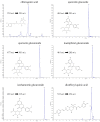UPLC-ESI-QTRAP-MS/MS Analysis to Quantify Bioactive Compounds in Fennel (Foeniculum vulgare Mill.) Waste with Potential Anti-Inflammatory Activity
- PMID: 36005573
- PMCID: PMC9414302
- DOI: 10.3390/metabo12080701
UPLC-ESI-QTRAP-MS/MS Analysis to Quantify Bioactive Compounds in Fennel (Foeniculum vulgare Mill.) Waste with Potential Anti-Inflammatory Activity
Abstract
Foeniculum vulgare is a perennial aromatic plant whose cultivation produces large amounts of waste rich in bioactive compounds with promising anti-inflammatory activities. Nine selected metabolites were quantified through Ultra Performance Liquid Chromatography (UPLC) hyphenated to QTRAP mass spectrometry by using MRM (multiple reaction monitoring) was performed on four parts of fennel: bulb, stem, little stem, and leaf. Analysis revealed significant differences in the amount of quantified metabolites, suggesting that little stem and leaf are the most valuable parts of the waste. Phenolic acids and glycosylated flavonoids were quantified for their known possible anti-inflammatory activities; in fact, due to this reason their ability to inhibit COX-1 and COX-2 isoforms was evaluated through a fluorometric assay, resulting in specific inhibitors of COX-2 at certain concentrations. In conclusion, as the leaf of fennel may be beneficial to human health, clinical studies should include it in nutraceuticals or functional foods for human consumption.
Keywords: anti-inflammatory activity; metabolomic analysis; vegetable waste.
Conflict of interest statement
The authors declare no conflict of interest.
Figures



Similar articles
-
A Targeted Mass Spectrometric Approach to Evaluate the Anti-Inflammatory Activity of the Major Metabolites of Foeniculum vulgare Mill. Waste in Human Bronchial Epithelium.Molecules. 2025 Mar 21;30(7):1407. doi: 10.3390/molecules30071407. Molecules. 2025. PMID: 40286023 Free PMC article.
-
A Comparative UHPLC-Q-Trap-MS/MS-Based Metabolomics Analysis to Distinguish Foeniculum vulgare Cultivars' Antioxidant Extracts.Molecules. 2023 Jan 16;28(2):900. doi: 10.3390/molecules28020900. Molecules. 2023. PMID: 36677955 Free PMC article.
-
LC-ESI/LTQOrbitrap/MS Metabolomic Analysis of Fennel Waste (Foeniculum vulgare Mill.) as a Byproduct Rich in Bioactive Compounds.Foods. 2021 Aug 15;10(8):1893. doi: 10.3390/foods10081893. Foods. 2021. PMID: 34441670 Free PMC article.
-
Foeniculum vulgare as Valuable Plant in Management of Women's Health.J Menopausal Med. 2019 Apr;25(1):1-14. doi: 10.6118/jmm.2019.25.1.1. Epub 2019 Apr 25. J Menopausal Med. 2019. PMID: 31080784 Free PMC article. Review.
-
Bioactive Compounds in Waste By-Products from Olive Oil Production: Applications and Structural Characterization by Mass Spectrometry Techniques.Foods. 2021 May 29;10(6):1236. doi: 10.3390/foods10061236. Foods. 2021. PMID: 34072297 Free PMC article. Review.
Cited by
-
Comparison of Vegetable Waste Byproducts of Selected Cultivars of Foeniculum vulgare Mill. by an Integrated LC-(HR)MS and 1H-NMR-Based Metabolomics Approach.Phytochem Anal. 2025 Jun;36(4):1017-1030. doi: 10.1002/pca.3488. Epub 2025 Jan 21. Phytochem Anal. 2025. PMID: 39837564 Free PMC article.
-
Foeniculum vulgare Mill. Mitigates Scopolamine-Induced Cognitive Deficits via Antioxidant and Neuroprotective Mechanisms in Zebrafish.Molecules. 2025 Jul 4;30(13):2858. doi: 10.3390/molecules30132858. Molecules. 2025. PMID: 40649373 Free PMC article.
-
A Targeted Mass Spectrometric Approach to Evaluate the Anti-Inflammatory Activity of the Major Metabolites of Foeniculum vulgare Mill. Waste in Human Bronchial Epithelium.Molecules. 2025 Mar 21;30(7):1407. doi: 10.3390/molecules30071407. Molecules. 2025. PMID: 40286023 Free PMC article.
-
A Comparative UHPLC-Q-Trap-MS/MS-Based Metabolomics Analysis to Distinguish Foeniculum vulgare Cultivars' Antioxidant Extracts.Molecules. 2023 Jan 16;28(2):900. doi: 10.3390/molecules28020900. Molecules. 2023. PMID: 36677955 Free PMC article.
-
The Role of LC-MS in Profiling Bioactive Compounds from Plant Waste for Cosmetic Applications: A General Overview.Plants (Basel). 2025 Jul 24;14(15):2284. doi: 10.3390/plants14152284. Plants (Basel). 2025. PMID: 40805633 Free PMC article. Review.
References
-
- Bernstein N., Akram M., Daniyal M., Koltai H., Fridlender M., Gorelick J., Sparks D.L. Chapter Four—Antiinflammatory Potential of Medicinal Plants: A Source for Therapeutic Secondary Metabolites. Adv. Agron. 2018;150:131–183.
-
- Salih M., Osman W., Garelnabi E., Osman Z., Osman B., Khalid H., Mohamed M. Secondary metabolites as anti-inflammatory agents. J. Phytopharm. 2014;3:275–285. doi: 10.31254/phyto.2014.3409. - DOI
LinkOut - more resources
Full Text Sources
Research Materials

